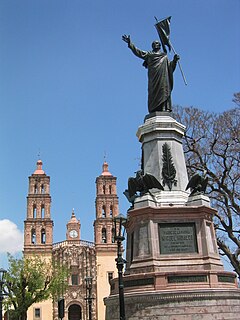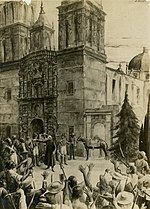Fiestas Patrias in Mexico originated in the 19th century and are observed today as five public holidays.

Don Miguel Gregorio Antonio Ignacio Hidalgo y Costilla Gallaga Mandarte y Villaseñor, more commonly known as Miguel Hidalgo y Costilla or Miguel Hidalgo, was a Catholic priest, leader of the Mexican War of Independence and recognized as the Father of the Nation.
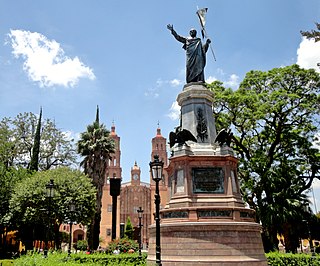
Dolores Hidalgo is the name of a city and the surrounding municipality in the north-central part of the Mexican state of Guanajuato.
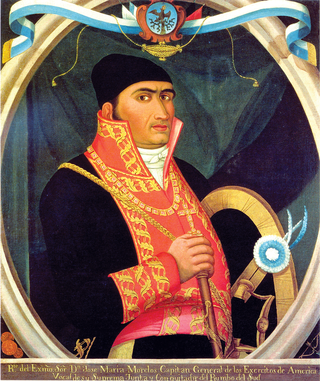
José María Teclo Morelos Pérez y Pavón was a Mexican Catholic priest, statesman and military leader who led the Mexican War of Independence movement, assuming its leadership after the execution of Miguel Hidalgo y Costilla in 1811.

The Mexican War of Independence was an armed conflict and political process resulting in Mexico's independence from the Spanish Empire. It was not a single, coherent event, but local and regional struggles that occurred within the same period, and can be considered a revolutionary civil war. It culminated with the drafting of the Declaration of Independence of the Mexican Empire in Mexico City on September 28, 1821, following the collapse of royal government and the military triumph of forces for independence.

Zócalo is the common name of the main square in central Mexico City. Prior to the colonial period, it was the main ceremonial center in the Aztec city of Tenochtitlan. The plaza used to be known simply as the "Main Square" or "Arms Square", and today its formal name is Plaza de la Constitución. This name does not come from any of the Mexican constitutions that have governed the country but rather from the Cádiz Constitution, which was signed in Spain in the year 1812. Even so, it is almost always called the Zócalo today. Plans were made to erect a column as a monument to independence, but only the base, or zócalo, was built. The plinth was buried long ago, but the name has lived on. Many other Mexican towns and cities, such as Oaxaca, Mérida, and Guadalajara, have adopted the word zócalo to refer to their main plazas, but not all.

María Josefa Crescencia Ortiz Téllez–Girón, popularly known as Doña Josefa Ortiz de Domínguez or La Corregidora was an insurgent and supporter of the Mexican War of Independence, which fought for independence against Spain, in the early 19th century. She was married to Miguel Domínguez, corregidor of the city of Querétaro, hence her nickname.

The Angel of Independence, most commonly known by the shortened name El Ángel and officially known as Monumento a la Independencia, is a victory column on a roundabout on the major thoroughfare of Paseo de la Reforma in downtown Mexico City.
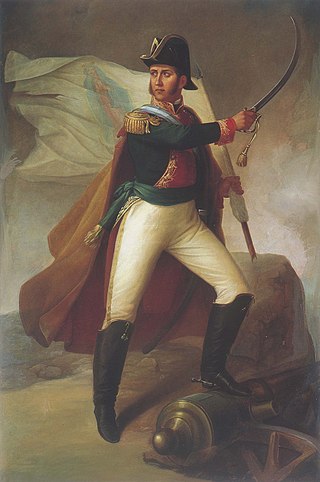
Ignacio José de Allende y Unzaga, commonly known as Ignacio Allende, was a captain of the Spanish Army in New Spain who came to sympathize with the Mexican independence movement. He attended the secret meetings organized by Josefa Ortiz de Domínguez, where the possibility of an independent Mexico was discussed. He fought along with Miguel Hidalgo y Costilla in the first stage of the struggle, eventually succeeding him in leadership of the rebellion. Allende was captured by Spanish colonial authorities while he was in Coahuila and executed for treason in Chihuahua.

Juan Aldama was a Mexican revolutionary rebel soldier during the Mexican War of Independence in 1810.

The National Palace is the seat of the federal executive in Mexico. Since 2018 it has also served as the official residence for the President of Mexico. It is located on Mexico City's main square, the Plaza de la Constitución. This site has been a palace for the ruling class of Mexico since the Aztec Empire, and much of the current palace's building materials are from the original one that belonged to the 16th-century leader Moctezuma II.

José Miguel Domínguez Alemán was a New Spanish colonial official in New Spain who played a part in the Mexican independence movement. He was also a member of a transitional governing committee in the period between the abdication of Mexican Emperor Agustín de Iturbide and the installation of Guadalupe Victoria as the first president of independent Mexico. His wife, Josefa Ortiz de Domínguez, also known as La Corregidora, was a heroine of Mexican independence.

Jerécuaro is a Mexican city located in the lowlands of the state of Guanajuato. The municipality has an area of 828.3 square kilometres and is bordered to the north by Apaseo el Alto, to the east by Coroneo and the state of Querétaro, to the south by Tarandacuao, to the southwest with Acámbaro, and to the northwest with Tarimoro. The municipality had 55,311 inhabitants according to the 2005 census. The municipal president of Jerécuaro and its many smaller outlying communities is C.Jaime García Cardona.

In 2010, Mexico celebrated both the 200th anniversary of its Independence and 100th anniversary of its Revolution. The entire year was proclaimed by President Felipe Calderón as "Año de la Patria", or "Year of the Nation". 16 September 1810 is the day of the "Grito de Dolores" or Miguel Hidalgo's call to take up arms against the Spanish colonial government. The start of the Mexican Revolution is celebrated as being 20 November 1910, when Francisco "Pancho" Villa and Pascual Orozco led the first insurrectionist attack against the regime of Porfirio Díaz. Events and other promotions of these celebrations were designed to link of Mexico's identity and historic continuity. During a speech at the inauguration of the Casa de Allende Historic Museum, President Felipe Calderón called upon Mexico to use the upcoming anniversaries to reflect on where the country has been and to think about what kind of Mexico descendants will inherit in the future. He said the vision of the insurgents of the War of Independence was forward, not backward, so every celebration of these past events must consider the future as well.
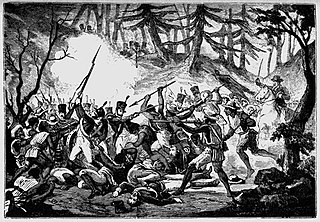
The Battle of Monte de las Cruces was one of the pivotal battles of the early Mexican War of Independence, in October 1810.

The Battle of Zitácuaro took place during the War of Mexican Independence on 2 January 1812 in the area around Zitácuaro, Michoacán. The battle was fought between the royalist forces loyal to the Spanish crown and the Mexican rebels fighting for independence from the Spanish Empire. The Mexican insurgents were commanded by General Ignacio López Rayón and the Spanish by Félix María Calleja. The battle resulted in a victory for the Spanish Royalists even in the face of overwhelming odds.

The Battle of Tecualoya was a military action of the Mexican War of Independence fought between 17–20 January 1812 in the canyons of Tecualoya, Mexico. The battle was fought between the royalist forces loyal to the Spanish crown and the Mexican rebels fighting for independence from the Spanish Empire. The Mexican insurgents were commanded by General Hermenegildo Galeana and the Spanish by Rosendo Porlier y Asteguieta. The battle resulted in a humiliating defeat for Galeana and his army. The Mexican insurgents lost all their artillery, though they would later recover these field pieces at the Battle of Tenancingo where General José María Oviedo would be killed in action.

Wells of Baján are water wells located between Saltillo and Monclova in the northern Mexican state of Coahuila. The small community near the wells is called Acatita de Baján. In the first phase of the Mexican War of Independence, revolutionary leaders Miguel Hidalgo, Ignacio Allende, José Mariano Jiménez, and Juan Aldama, plus nearly 900 men in the rebel army were captured here on March 21, 1811, by 150 soldiers commanded by Ignacio Elizondo. Elizondo pretended to be a supporter of the struggle to overthrow Spanish rule, lured the rebels into a trap, and captured them with little resistance. The four leaders and many of their followers were tried and executed.
Ramón Fabié y de Jesús was a Philippines-born Mexican mining engineering student who joined revolutionaries in the Mexican War of Independence.

The Capture of Alhóndiga de Granaditas was a military action carried out in Guanajuato, viceroyalty of New Spain, on September 28, 1810, between the royalist soldiers of the province and the insurgents commanded by Miguel Hidalgo and Ignacio Allende. The fear unleashed in the social circles of the provincial capital made the intendant, Juan Antonio Riaño, ask the population to barrack in the Alhóndiga de Granaditas, a granary built in 1800, and in whose construction Miguel Hidalgo had participated as an advisor to his old friend Riaño. After several hours of combat, Riaño was killed and the Spaniards who had taken refuge there wished to surrender. The military in the viceroy's service continued the fight, until the insurgents managed to enter and then massacred not only the few guards that defended it, but also the numerous families of civilians who had taken refuge there. Many historians consider this confrontation more like a mutiny or massacre of civilians than a battle, since there were no conditions of military equality between the two sides.
